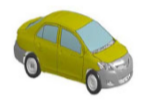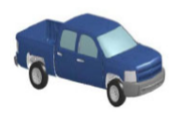Thrie beam guardrail systems are used when a higher level of protection than what is typically provided with W-beam guardrail is necessary. One example of this is when a fixed object is in close proximity to the roadway. Concrete barriers are often available to provide adequate protection in these cases, but they commonly present a stiffer impact during a collision, may have a larger footprint and foundation requirement, and their cost is typically much higher than thrie beam systems. On the other hand, a thrie beam system typically allows more deflection than concrete barriers. Therefore, the Roadside Safety Pooled Fund has prioritized an effort to develop a thrie beam guardrail system that provides minimal dynamic deflection and would be available as an alternative to concrete barriers.
The research objective is to develop a thrie beam guardrail system that minimizes the dynamic deflection during an impact. This system will be crash tested to AASHTO Manual for Assessing Safety Hardware (MASH) (1) specifications.
This project will benefit the members of the Roadside Safety Pooled Fund by providing design for a thrie beam guardrail which can be implemented on the roadside when minimal dynamic deflection is needed. This system has the potential of providing a more cost-effective alternative to rigid concrete barriers when fixed objects are in close proximity to the roadway.
The TTI research team will prepare and submit a research report fully documenting all of the work completed within this project. Application documentation for an FHWA Eligibility Letter will be provided if applicable. If not, the research team will provide engineering justification explaining that the critical tests were performed.
With the tested thrie beam guardrail system, the Roadside Safety Pooled Fund will have a cost-effective MASH-compliant method to protect errant motorists from fixed objects.
In this task, the research team will review the current literature and previous research related to thrie beam guardrail systems. The research team will then develop a preliminary design that provides a “close to rigid” condition. Finally, the research team will involve a computer simulation portion to evaluate the system before full-scale testing.
The TTI research team will use the explicit finite element code, LS-DYNA, to perform impact simulations using the developed barrier model, and available vehicle models as shown in Figure 1 (2, 3). These models include (a) Toyota Yaris model representing a 2420-lb (1100C) MASH small car test vehicle, and (b) Chevrolet Silverado mode representing a 5000-lb (2270P) MASH pickup test vehicle. The impact simulations will be representing MASH Tests 3-10 and 3-11. Both of these tests require an impact speed of 62 mph and an impact angle of 25 degrees.
 (a) Toyota Yaris (2420-lb) (a) Toyota Yaris (2420-lb) |
 (b) Chevrolet Silverado (5000-lb) (b) Chevrolet Silverado (5000-lb) |
Figure 1. Available Finite Element Models (2, 3).
The TTI research team will use a combination of previous research, MASH guidelines, and computer simulations to determine the critical impact points for the MASH crash testing. Once the critical impact points have been determined, the TTI research team will consult the findings with the technical representative before beginning installation and crash testing.
Figure 2 shows a design detail from the Washington State Department of Transportation (WSDOT) (4). This detail, which includes the system itself and required transitions back to W-beam barrier, will serve as the foundation of this design effort. The exception is that it is anticipated that the system will stand alone and that the blockout to the fixed feature that is shown in the detail will not be part of the design. The research team will start with this design and make appropriate modifications to improve the crashworthy performance and cost-effectiveness.
Figure 2. Current WsDOT Detail (4).
The TTI research team will complete two full-scale MASH crash tests on the thrie beam guardrail system. The two tests will be MASH Test 3-11 and 3-10. These tests include the MASH 2270P (5000-lb) pickup truck and the MASH 1100C (2420-lb) small car.
| TTI Research Supervisor: James C. Kovar, E.I.T. Associate Transportation Researcher Texas A&M Transportation Institute TAMU 3135 College Station, Texas 77843-3135 (979) 317-2680 [email protected] |
Pooled Fund Technical Representative: John Donahue Design Policy and Analysis Manager Washington State Department of Transportation Development Division P.O. Box 47329 Olympia, WA 98504-7246 (360) 705-7246 [email protected] |
REFERENCES
2020-04-01
